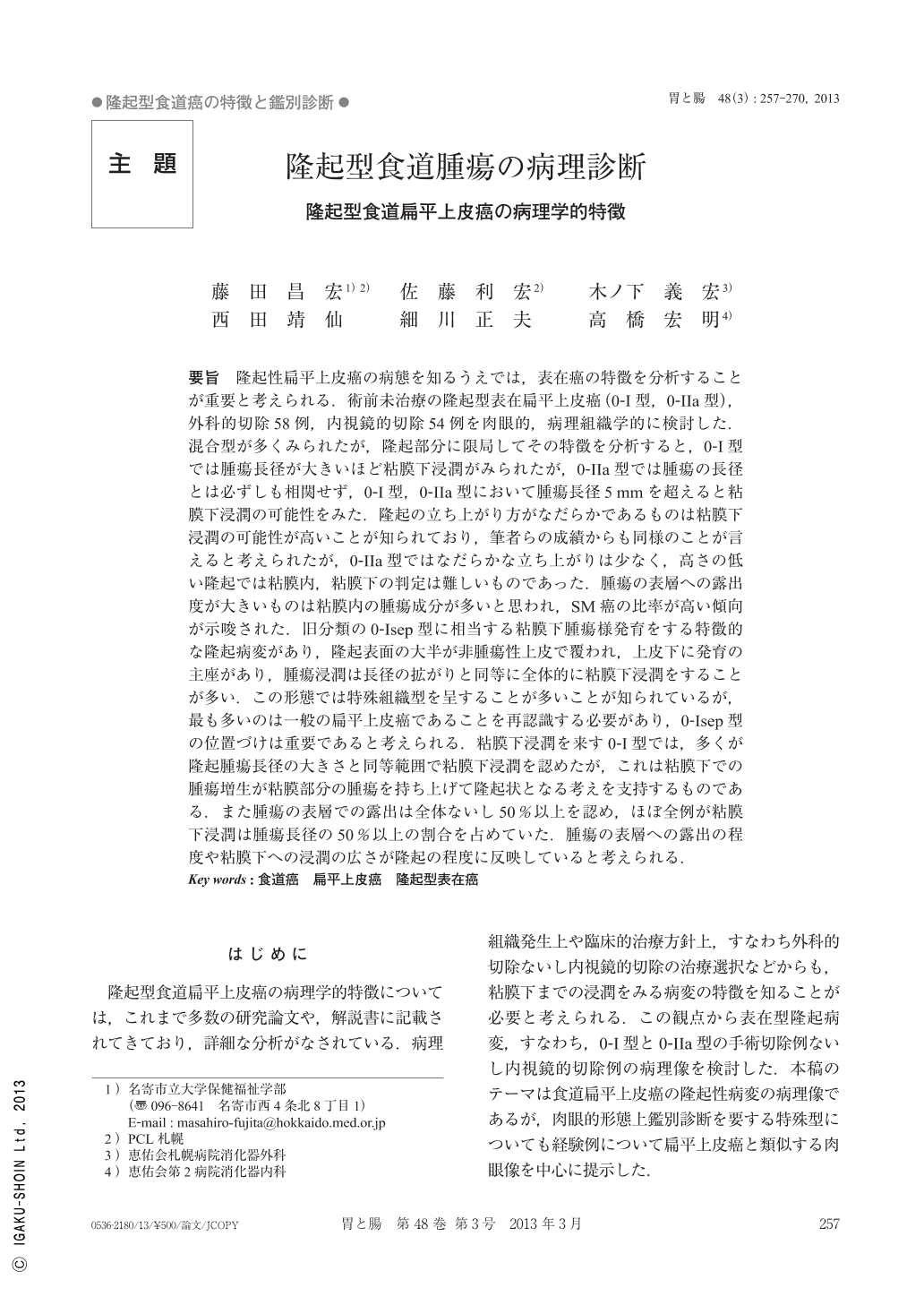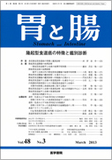Japanese
English
- 有料閲覧
- Abstract 文献概要
- 1ページ目 Look Inside
- 参考文献 Reference
要旨 隆起性扁平上皮癌の病態を知るうえでは,表在癌の特徴を分析することが重要と考えられる.術前未治療の隆起型表在扁平上皮癌(0-I型,0-IIa型),外科的切除58例,内視鏡的切除54例を肉眼的,病理組織学的に検討した.混合型が多くみられたが,隆起部分に限局してその特徴を分析すると,0-I型では腫瘍長径が大きいほど粘膜下浸潤がみられたが,0-IIa型では腫瘍の長径とは必ずしも相関せず,0-I型,0-IIa型において腫瘍長径5mmを超えると粘膜下浸潤の可能性をみた.隆起の立ち上がり方がなだらかであるものは粘膜下浸潤の可能性が高いことが知られており,筆者らの成績からも同様のことが言えると考えられたが,0-IIa型ではなだらかな立ち上がりは少なく,高さの低い隆起では粘膜内,粘膜下の判定は難しいものであった.腫瘍の表層への露出度が大きいものは粘膜内の腫瘍成分が多いと思われ,SM癌の比率が高い傾向が示唆された.旧分類の0-Isep型に相当する粘膜下腫瘍様発育をする特徴的な隆起病変があり,隆起表面の大半が非腫瘍性上皮で覆われ,上皮下に発育の主座があり,腫瘍浸潤は長径の拡がりと同等に全体的に粘膜下浸潤をすることが多い.この形態では特殊組織型を呈することが多いことが知られているが,最も多いのは一般の扁平上皮癌であることを再認識する必要があり,0-Isep型の位置づけは重要であると考えられる.粘膜下浸潤を来す0-I型では,多くが隆起腫瘍長径の大きさと同等範囲で粘膜下浸潤を認めたが,これは粘膜下での腫瘍増生が粘膜部分の腫瘍を持ち上げて隆起状となる考えを支持するものである.また腫瘍の表層での露出は全体ないし50%以上を認め,ほぼ全例が粘膜下浸潤は腫瘍長径の50%以上の割合を占めていた.腫瘍の表層への露出の程度や粘膜下への浸潤の広さが隆起の程度に反映していると考えられる.
It is important to analyze the characteristics of superficial cancers to know the pathogenesis of the elevated growth of squamous cell carcinoma.
We examined macroscopically and histopathologically untreated elevated-type squamous cell carcinoma before ; surgical resection in 58 patients, and 54 patients with endoscopic resection.
There were many mixed typed carcinomas, but we analyzed their features in the elevated lesions.
Submucosal invasion was found in many large tumors with high elevation(protuberance)(type 0-I), but there was no correlation between tumor size and depth of invasion in tumors of low elevation(type 0-IIa).
When the rising edge of the elevated part is gentle, it causes a high percentage of submucosal invasion, but in tumor of low elevation(type IIa)it is difficult to distinguish grossly between intramucosal cancer and submucosal cancer.
The degree of exposure to the mucosal surface of a tumor was more likely to be seen as a large component of the tumor in the mucosa, and in submucosal invasion.
There is a characteristic tendency in the lesion to the development of submucosal tumor. A major part of the surface of the lesion is covered by a raised non-neoplastic epithelium and the extent of tumor invasion is equal to the maximum diameter of the tumor spread and overall invasion to the submucosa.
This form often shows a specific pathological tissue type, and it is necessary to recognize in practice that it is most often squamous cell carcinoma.
In many cases of the 0-I type of tumor that invades to the submucosa, submucosal infiltration was observed to be roughly equal to the maximum diameter of the elevated tumor. This finding supports the idea that submucosal tumor development gives rise to an elevated tumor by raising the tumor in the part of the mucosa that is above it.
The tumor exposure occupied the whole or more than 50% of the surface. In almost all cases, submucosal infiltration occupied more than 50% of the surface of the maximum diameter of the tumor.
It is conceivable that the degree of the surface exposure of the tumor and the degree of submucosal invasion reflect the degree of elevation.

Copyright © 2013, Igaku-Shoin Ltd. All rights reserved.


